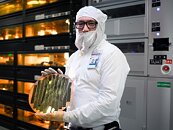- Joined
- Oct 9, 2007
- Messages
- 47,668 (7.43/day)
- Location
- Dublin, Ireland
| System Name | RBMK-1000 |
|---|---|
| Processor | AMD Ryzen 7 5700G |
| Motherboard | Gigabyte B550 AORUS Elite V2 |
| Cooling | DeepCool Gammax L240 V2 |
| Memory | 2x 16GB DDR4-3200 |
| Video Card(s) | Galax RTX 4070 Ti EX |
| Storage | Samsung 990 1TB |
| Display(s) | BenQ 1440p 60 Hz 27-inch |
| Case | Corsair Carbide 100R |
| Audio Device(s) | ASUS SupremeFX S1220A |
| Power Supply | Cooler Master MWE Gold 650W |
| Mouse | ASUS ROG Strix Impact |
| Keyboard | Gamdias Hermes E2 |
| Software | Windows 11 Pro |
In case you're wondering why Intel went with TSMC 3 nm to build the Compute tile of its "Arrow Lake" processor, and the SoC tile of "Lunar Lake," instead of Intel 3, or even Intel 20A, perhaps there's more to the recent story about Broadcom voicing its disappointment in the Intel 18A foundry node. The September 2024 report didn't specify a number to what yields on the Intel 18A node looked like to spook Broadcom, but we now have some idea as to just how bad things are. Korean publication Chosun, which tracks developments in the electronics and ICT industries, reports that yields on the Intel 18A foundry node stand at an abysmal 10%, making it unfit for mass-production. Broadcom validated Intel 18A as it was prospecting a cutting-edge node for its high-bandwidth network processors.
The report also hints that Intel's in-house foundry nodes going off the rails could be an important event leading up to the company's Board letting go of former CEO Pat Gelsinger, as huge 2nd order effects will be felt across the company's entire product stack in development. For example, company roadmaps put the company's next-generation "Clearwater Forest" server processor, slated for 2025, as being designed for the Intel 18A node. Unless Intel Foundry can pull a miracle, an effort must be underway to redesign the chip for whichever TSMC node is considered cutting-edge in 2025.

View at TechPowerUp Main Site | Source
The report also hints that Intel's in-house foundry nodes going off the rails could be an important event leading up to the company's Board letting go of former CEO Pat Gelsinger, as huge 2nd order effects will be felt across the company's entire product stack in development. For example, company roadmaps put the company's next-generation "Clearwater Forest" server processor, slated for 2025, as being designed for the Intel 18A node. Unless Intel Foundry can pull a miracle, an effort must be underway to redesign the chip for whichever TSMC node is considered cutting-edge in 2025.

View at TechPowerUp Main Site | Source




